
- Home
- Listed By
- Material
- Style
- Subject
- -------- (31)
- --------, Military (8)
- Aircraft (61)
- Aircraft, Military (30)
- Art & Photography (2)
- Eagle (13)
- Education (4)
- History (61)
- History, Military (8)
- Literature & Fiction (4)
- Luftwaffe (8)
- Military (106)
- Military & Political (60)
- Military, -------- (4)
- Mustang (4)
- Paris (2)
- Royal Navy Ship (2)
- Stars (4)
- Transportation (72)
- Women (3)
- Other (711)
- Theme
- Type
- Art Print (72)
- Art Prints (2)
- Autographed Magazine (4)
- Aviation Art (2)
- Aviation Art Print (3)
- Film (4)
- Hardcover (9)
- Limited Edition (5)
- Lithograph (5)
- Military (5)
- Novel (3)
- Painting (11)
- Photograph (5)
- Print (740)
- Prints (8)
- Ring (2)
- Science / Space (2)
- Sculpture (7)
- Signed Lithograph (2)
- Other (307)
Eagle Squadron Scramble Robert Taylor pen signed 18 veterans Great Escape



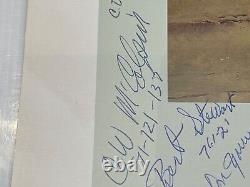
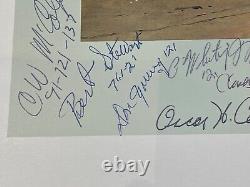

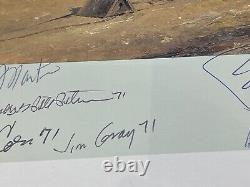

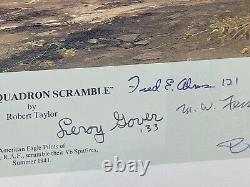

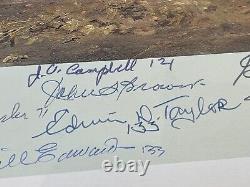






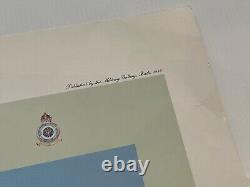



Eagle Squadron Scramble - Robert Taylor pen signed 21 veterans including a Great Escape veteran, the inspiration for the Steve McQueen character in the film. James Gray Michael Miluck George Brooks Sperry John'Red' Cambell Edwin Dale Taylor DFC Morris W Fessler Fred Elbert Almos John Innes Brown III Don'Snuffy' Smith DFC Jackson Barrett Mahon DFC Donald A Young Reade Franklin Tilley DFC Carroll W McColpin Arthur Roscoe DFC Steve Pisanos Cadman V Padgett Hubert Layton Stewart Nicholas D. Poor condition on the border with dings and folds but the image will look fine if mounted & framed. It would be a shame to cut the sigs off unless you have a particular location to place them that works better for you.
Jackson Mahon was a PoW in Stalag Luft III and having escaped and been caught near Prague he was in the'cooler' when the Great Escape happened. This was the inspiration for the Steve McQueen "Cooler King" character and he acted as an advisor on the film.
Photos have been not been edited. The price will rise a bit as the weight goes up too much. I have spent the last 30 years collecting WW2 memorabilia and particularly art prints by Robert Taylor, Nicolas Trudgian and others, with an eye to the print but also the signatures. Reade Franklin Tilley DFC - A native of Clearwater, Florida, Reade Tilley grew up with a love for competition in the fast lane. This made Reade natural for driving race cars and the military equivalent; fighter pilot.Petersburg College in Florida and the University of Texas at Austin, Reade was faced with the difficult choice of deciding whether to continue to pursue his race car driving career or become a fighter pilot. With war raging in Europe, Reade opted for the latter, and joined the Royal Canadian Air Force in 1940. In 1941 he was assigned to No. 121 Eagle Squadron of the RAF. This was one of the three American-manned squadrons in the RAF.
Reading of the horrific air attacks being endured by the people of the besieged Island of Malta, Reade volunteered for a daring mission to launch landbased Spitfires from the USS Wasp to relieve the forces on the island. On the morning of April 20, 1942 forty-seven Spits, including one flown by Tilley, were launched from the Wasp.The arrival of these fighters was very important in saving the strategic island from annihilation by the Nazis. Arriving safely in Malta, Tilley would soon fly in combat, and on his second mission he would down a Bf-109. The Luftwaffe launched an all-out effort to destroy the recently arrived Spitfires, and within a matter of days all of the newly arrived aircraft were either destroyed or damaged. During his combat tours at Malta, Tilley attained a total of seven confirmed aerial victories, two probables, and five damaged.
He was one of the first two American pilots to be awarded the Distinguished Flying Cross during the defense of Malta. The citation reads in part:...
On three occasions by making feint attacks after having expended his ammunition he successfully drove off enemy fighters attempting to machine gun our aircraft as they landed... Reade was promoted to Flying Officer in August of 1942, and in October he transferred to the USAAC with the rank of Captain. In early 1944 he was promoted to the rank of Major. Tilley remained with the USAF following the War and served initially with the USAFE, the Air Forces in Europe, where he was involved with the Berlin Air Lift. Later Tilley would serve with the Strategic Air Command.Promoted to Colonel in 1955, he served as the Director of Public Information for General Curtis LeMay. During this period Tilley was able to hone his race car driving skills as a member of the SAC Racing Team. Driving an Allard, Tilley competed against some of the top professional drivers of the era in a series of road race competitions at Air Force bases throughout the country.
Reade also served as Director of Information for Pacific Air Forces during the Vietnam War. After retiring from the Air Force, he became a consultant. Reade Tilley passed away in 2001.
John'Red' Cambell - flew Spitfires with 234 Squadron, before joining 121 Eagle Squadron. After the transfer of the Eagles to the USAAF, John chose to remain with the RAF and was posted to 258 Squadron for the final defence of Singapore, and then to 605 Squadron defending Java. With four victories in the Far East to his credit, in March 1942 the squadron was over-run by the Japanese, and John became a POW in a harsh prison camp in Java for the next 3 and a half years. Don'Snuffy' Smith DFC - Served in 121 Eagle Squadron then transferred to the AAF. Assigned to 335FS, 4FG, 8AF USAAF.
He scored 3 kills in P-47s. Failed to Return (FTR) bomber escort to Joigny, France. Cadman V Padgett - 335FS, 4FG, 8AF USAAF. Joined RAFVR, assigned 121S, transferred to 335th FS, 4th FG, 8AF USAAF, Promoted to 1st Lt, designated Assistant Squadron Engineering Officer 20-1-43, Promoted to Captain 30-11-43. Operations Officer, Andrews AFB, Maryland. Flew in the Korean War. Appointed C/O, 52nd Airlift Squadron Rhein-Main AB, Germany 12-1954. Hubert Layton Stewart - 334th FS, 4th FG, 8AF USAAF, formerly of 71 and 121 Eagle Sqn's RAF.Born January 15, 1913 in Johnston County, North Carolina. Hubert L'Bert' Stewart left North Carolina in 1939 determined to fly and fight Hitler and so he enlisted in the RCAF, after flight school, by Oct 40 he was assigned to be an instructor at and to remain in New Brunswick, Canada.
Having met some'Eagles' in transit he went AWOL, stowing away aboard a troopship to England. In spite of Canada's attempts to punish him for desertion "toward the enemy, " England was facing the Battle of Britain, so the RAF put him through an OTU and into a Spitfire in 121 Sqn RAF as a Flight Sgt and later commissioned him a Flying Officer mid Aug 41. Transferred to 71 Sqn RAF as a combat replacement 21-9-41. He met an Australian newspaper reporter, Elaine Howells, during the Blitz of London - starting a lifetime marriage.After Pearl Harbor, he and most of his Eagle Squadron brethren changed uniforms and became the experienced core of America's newly formed 4th FG - destroying more enemy aircraft than any other during the war. After VE Day, tour expired, Bert went to the Pacific Theater and flew fighters against the Empire of Japan until their surrender. He left the Air Force as a Major.
He joined the Royal Air Force Volunteer Reserve in 1941, serving initially as a Flying Officer in No. 121 Squadron, his injuries and service in the United States Army Air Forces. He was awarded the Air Medal with 4 oak leaf clusters, the World War II Victory Medal and the European-African-Middle Eastern Campaign Medal with 2 bronze stars. Donald A Young - 335th FS, 4th FG, 8AF USAAF former 121 [Eagle] Sqn RAF Spitfire pilot. Joined Finnish AF, Joined Norwegian AF, Joined RAFVR.
61 OTU, 121 Squadron 2-6-41 / 24 September 1942. 335FS 24 September 1942 - 9 October 1943. Promoted to 1st Lieutenant 3-43. Flew on the first P-47 combat mission 10 March 1943. ASC, Commanding Officer, Headquarters Squadron Patterson Field, Ohio Retired from the USAF as a Lieutenant Colonel.Fred Elbert Almos - Joined RAFVR, Spitfire pilot 121 [Eagle] Sqn RAF. Delivered Spitfire [1 of 47] to Malta from USS Wasp 20th Apr 42. Joined 126 Sqn RAF on Malta.
He undertook service pilot training in Tulsa, Oklahoma, USA in 1940 and later that year he joined the Royal Air Force Volunteer Reserve in Canada coming to England where he landed in Liverpool, Lancashire. On 20 April 1942 he flew one of the 47 Spitfires from the aircraft carrier USS Wasp to Malta where he was assigned to No. 126 Squadron and took part in the defence of Malta. Jackson Barrett Mahon DFC - born in Bakersfield, California, and learned to fly while in high school. In 1941 he joined the Royal Air Force, and by the winter was flying combat with No 121 (Eagle) Squadron, composed of American volunteers. Pilot Officer Mahon damaged three German fighters, two FW-190s in April and an Me-109 in May, before scoring his first confirmed victories of two FW-190s, downed in the Saint-Omer area, on June 8, 1942.On July 31 he destroyed two more FW-190s over the Berck-Sur-Mer area and became an Ace while covering the commando raid on Dieppe, August 19, 1942, his 98th fighter pilot mission. Landing in the sea, he was taken prisoner. Although Mahon filed a claim for shooting down two Germans that day, he was only given credit for one after the war.
Thus, for a tally-record of five confirmed, two probables, three damaged, in 98 combat missions and other brave and heroic deeds, Mahon received the British Distinguished Flying Cross in 1945. Officially listed as "missing", the British Air Ministry awarded him the Distinguished Flying Cross, noting in his citation that he was an extremely skillful and confident pilot, whose courage, especially when attacking superior numbers of hostile aircraft, had been unsurpassed. As a German prisoner, Barry was sent to Stalag Luft III, a special prison camp the Germans reserved for airmen. Barry's first escape was nearly successful, he reached the Czech border before he was recaptured, due to feet so sore he couldnt go on and was placed in solitary confinement.
Recaptured, he was back in the "cooler" when 76 of his comrades slipped out through tunnels in what would later be called "The Great Escape". But for his confinement at the time of the escape, Barry would have been among them. It was a stroke of fortune for the man who would later serve as a technical advisor during creation of a 1963 movie in which Steve McQueen would portray Barry's character. Finally liberated by Patton's 3rd Army 29th April 1945. After the war he became the personal pilot for, and later the manager of, Errol Flynn.
Having produced a number of Flynn and Gina Lollobrigida pictures, as well as a considerable output of children's programs, Mahon established The Production Machine, a high-tech film production company in Hollywood, making motion pictures for theatrical and television release. Mahon was the first movie producer to adapt and apply computer technology (as well spreadsheet applications, such as MultiPlan) to the breakdown, scheduling, budgeting and financial analysis of feature-length motion pictures and movies-of-the-week for Columbia Pictures. James Gray - was in college and taking a civilian pilot training course when the European war began. I tried for the U. Army Air Corps and couldn't pass the physical, he says.
I heard that the British were recruiting pilots for the Royal Air Force. I wanted to fly a fast fighter. Like many prospective Eagle Squadron pilots, Gray went to a special school in the United States and learned flying from former U. James Gray joined the RAF as an American volunteer in September 1941, and was posted to 71 Eagle Squadron flying Spitfire Vbs. Gray's first missions in the Spitfire were mostly convoy patrols over the English Channel.By September of 1941, the faster Spitfire Mk. IIs, and along with the aircraft change came Eagle missions of a little more range - sweeps across the Channel into France. These missions were dubbed Rhubarbs, Circuses and Rodeos, depending on the number of aircraft used, their tactics and varied methods of enticing the Luftwaffe to fight. Gray says he shot down his first enemy plane in the spring of 1942. The day before, some RAF bombers had been badly shot up on a major operation.
Rescue boats went out looking for aircrew that might still be floating in dinghies, and Spitfires were sent to provide air cover for the operation. While on this patrol they were attacked by a number of Fw190's. Gray attacked one of the Fw190s which was pursuing Wing Leader Bob Sprague's Spitfire, Gray opened fire with his cannons and sent the Fw190 plunging into the sea. Staying in the RAF throughout the war, he flew Spitfires in North Africa and the Mediterranean, first with 93 Squadron, and later 111 Squadron. His luck eventually ran out in Italy when he was shot down early in 1945 whilst serving with 72 Squadron.
Flight Lieutenant James Gray was shot down on January 4th, 1945, his 26th birthday. Gray's Squadron's Spitfire IXs were carrying 500-pound bombs in ground attacks against German troops in northern Italy. He was taken POW for four months in Stalag-Luft I, north of Berlin. Among Flight Lieutenant James Gray's awards and decorations is the prestigious British Distinguished Flying Cross (DFC). After the war Flight Lieutenant James Gray became a pilot for United Airlines, started flying the DC-3, then flew the Convair 340 and, after a long successful career, retired as a Captain in DC-8 jets.
He was also the historian for the Eagle Squadrons. James Gray at the age of 90 passed away on the 25th of November 2009. Arthur Roscoe DFC - American Art Roscoe joined the RAF in February 1941, through the Clayton Knight Committee that was recruiting American civilian pilots for the RAF.
Arriving in England he joined 71 Eagle Squadron, where he made his first claims. In June 1942 he volunteered for service on Malta and flew off the carrier HMS Furious on 11th August to join 229 Squadron. During his final combat on 12th October he was shot down, wounded and evacuated from the island in a Liberator, which in turn crashed on landing in Gibraltar. On recovery, he was posted to join 165 Squadron, then 242 Squadron, and in May 1944 was given command of 232 Squadron.
He had destroyed 4 enemy aircraft and probably 3 more. Morris W Fessler - Pilot Officer, 71 Eagle Squadron, American. Destoying the engine, his Spitfire was hit with debris, and he belly landed in a field. He set his kite on fire and hid from the Germans the rest of the day. He was helped by a French family, and to avoid them being shot for helping him, he turned himslf in to the Germans.Then he went to Stalag Luft III. Carroll W McColpin - Carroll Red McColpin volunteered for the RAF in 1940 despite official US disapproval, going via Canada to England. 607 Squadron, he became the second Eagle Ace after shooting down two ME-109s on October 2, 1941 and is the only pilot known to have fought in aerial combat to a draw - with Werner Molders, the high-scoring German Ace. Red McColpin commanded 133 Eagle Squadron up to the transfer to the USAAF in September, 1942, General McColpin was the only American to fly combat in all three RAF American Eagle Squadrons. His total missions in these Squadrons exceeded three hundred counting the ones he flew with the 607.
He was a double ace before Pearl Harbor and was the first American to be decorated, in Buckingham Palace by King George during World War II. McColpin joined the 4th Figher Group. He later led the 404th Fighter Group in support of the D-Day invasion and the drive across Europe.
In 400 missions, he recorded 11.5 victories and collected 29 awards for gallantry. Following the war, McColpin remained in the Air Force, serving in several command and senior staff positions, ultimately becoming the commander of the 4th Air Force. He retired as a Major General in August, 1968. Michael Miluck - American volunteer Michael Miluck arrived in the UK in September 1941, and was posted to join 71 Eagle Squadron. Flying Spitfire Mk Vbs the squadron was engaged in escort and offensive fighter sweeps over the channel and northern France, taking part in the air cover over Dieppe. Later he flew Hurricanes with 250 Squadron. Steve Pisanos - Born Nov. 10, 1919, in the Athens suburb of Kolonos, Spiros Nicholas'Steve' Pisanos, the son of a subway motorman, arrived in America in April 1938 as a crew member on a Greek merchant tramp steamer. In August 1940, he settled in Plainfield, New Jersey, and continued flying lessons at Westfield Airport. He earned a private pilot's license and, though still a Greek national, in October 1941 he joined the British Royal Air Force sponsored by the Clayton Knight Committee in New York City. Pisanos began his military flight training at Polaris Flight Academy in Glendale. Upon graduation, Pilot Officer Pisanos was transferred to England where he completed RAF Officers Training School at Cosford, England, and OTU (Operational Training Unit) at Old Sarum Aerodrome in Salisbury. Pisanos was posted to the 268 Fighter Squadron at Snailwell Aerodrome in Newmarket flying P-51A's. He later transferred to the 71 Eagle Squadron, one of three Eagle squadrons in the RAF, comprised of just 244 American volunteers flying Spitfires at Debden RAF Aerodrome. When the USAAF 4th Fighter Group absorbed the American members of the Eagle Squadrons in September and October 1942, Pisanos was commissioned a lieutenant in the U. Flying his first mission in his P-47'Miss Plainfield' out of Debden Aerodrome with the 334th Fighter Squadron, 4th Fighter Group, Lt. Pisanos,'The Flying Greek,' scored his first shootdown on May 21, 1943, when he targeted a German FW-190 over Ghent, Belgium. 1, 1944, he had become an ace with five confirmed downings. On March 5, 1944, he obtained his 10th shootdown and while returning from that B-17 escort mission to Limoges and Bordeaux, France, Pisanos experienced engine failure in his P-51B and crash-landed south of Le Havre.For six months he evaded the Germans and fought with the French Resistance and the American OSS, sabotaging the German war machine in occupied France. 2, 1944, following the liberation of Paris. Because of his exposure and knowledge of the French Resistance operations, Pisanos was prohibited from flying additional combat missions because the Air Force could not risk him being captured.
Upon returning to the United States, Capt. Pisanos was assigned to the Flight Test Division at Wright Field, Ohio. He attended the USAF Test Pilot School and served as a test pilot at Wright Field and Muroc Lake, California, testing the YP-80 jet aircraft, America's first operational jet. During his Air Force career, Pisanos graduated from the University of Maryland, attended the Air Command and Staff College and the Air War College. Pisanos also served tours of duty in Vietnam (1967-68) and with NORAD before retiring from the USAF with the rank of colonel in in December 1973. Edwin Dale Taylor DFC - Joined RAFVR, operational training at OTU, assigned to 121 Sqn RAF, transferred to 133 Sqn RAF. 31-May-42 Fw190 Damaged, 31-Jul-42 3 x E/A Destroyed 1 x Damaged, Wounded in Action (WIA). Nomination for DFC lost in change of squadron command.Assigned to 406FS, 371FG, 9AF USAAF. Sqn C/O ranked Major, Jul-43, to Sep-44. George Brooks Sperry - had a private pilot's licence before he joined RAFVR in 1940.
He was assigned to No 133 Squadron of the RAF then, transferred to 336FS, 4FG 8AF USAAF. On 26 September 1942 Sperry crashed near Morlaix in Spitfire BR638 after running out of fuel. Upon reaching the ground he played a game of cat and mouse with German Patrols across the French countryside before eventually being captured and taken Prisoner of War (POW). Sperry recalled that he was taken to a Luftwaffe base where he was'stuffed with food, champagne, brandy and cigars'. The next day, when they picked us up to take us to the prison camp, the whole damn squadron came down to the station to see us off and they loaded us down with brandy, wine and fruit.
Sintetos - born in Ashtabula, Ohio on November 10, 1920. He was the son of a Greek Immigrants couple. His father, Dimitrios Sintetos was from a mountainous village in Arcadia District, Peloponnese named Vasta. He immigrated to the United States in 1906.His mother, Hellen Delligiannis was also from Arcadia, from a small village outside Tripoli named Agios Vasilios. She came to America in 1914 where he met Dimitrios, get married, and had 4 children. The outbreak of WW2, the dogfights over France and England as well as Italy's attack on Greece on October 28, 1940, were enough reasons for him, in order to fill his papers and join the United States Army Air Force.
Although he already held a Private Pilots Licence he was not accepted in USAAF because it was required to have two years of college studies before being able to apply for a flying cadet. He was not discouraged and knowing that RAF needed as many pilots could get, he traveled in Canada and applied for RCAF. Attending the British Commonwealth Advanced Training Program (BCATP) he was qualified as a multi-engine aircraft pilot and later was sent to England to join one of the RAF light bomber operational training squadrons.
However, he always wanted to be a fighter pilot, and using cunning methods he managed to transfer to a fighter OTU. Completing his training and being an American citizen he was posted to the famous Eagle Squadrons, manned mainly by American pilots. 121 Squadron, flying numerous offensive missions over France, participating in dogfights where he was credited with a damaged Fw-190. Although he saw plenty of action while operating from England he applied for transfer in Malta because as he told in one of his interviews, he was trying to get rid of the deadly anti-aircraft fire! Malta was known as the fighter pilot's paradise and he was sure that he would be able to participate in many dogfights. The Malta defenders were gaining the same publicity as their Battle of Britain fellow pilots. He was posted to the No.126 Squadron (also manned by many Americans), some days after the famous John Plagis left the island for England. He flew many sorties and had many adventures during his service in the sieged island and he was credited with one probable kill. Unfortunately his Squadron Leader, Flt/Lt. Bryan Wicks disliked him and his attitude almost cost the young Greek-American pilots life.
Sintetos was a great wingman who was proud of not having lost a pilot who was flying with him. In September 1942 he was transferred from RAF to the USAAF and he joined the 64th Fighter Squadron of the 57th Fighter Group, flying the P-40 Warhawk over North Africa. He was discharged in 1945 and he worked in real estate as well as creating his own inventions and patents. He passed away on November 9, 1999, at 79 years old in San Bernardino California.

